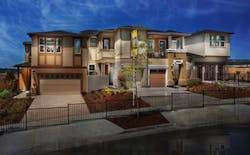KB Home opens ten San Francisco-area communities
KB Home announced the opening of ten new San Francisco Bay Area communities of its signature Built to Order energy-efficient homes, according to a press release.
The communities are located in seven of the Bay Area's most desired submarkets including the cities of Dublin, Fremont, Martinez, Morgan Hill, Petaluma and Walnut Creek. Six of the new communities, offering a wide array of both single family and attached town home designs, are now open, with four additional communities scheduled to open by early autumn.
In the last month, KB Home has celebrated the grand opening of Bella Monte in Dublin, Sterling Hills and Stone Ridge at Quarry Heights in Petaluma, Highlands Place in Martinez, Walden Park in Walnut Creek and Mission Ridge in Fremont. Model homes showcasing designs available are open for tours daily at all six communities. Additional communities in Morgan Hill and Santa Clara are planned to open in September.
All these homes will be Built to Order, meaning that the homebuyers select their homesite and floor plan and can customize their new home to suit their needs through structural options, varying exterior styles and finishing design details.
All homes will also be both ENERGY STAR qualified and GreenPoint Rated, meaning they have been designed and built to operate more efficiently and help save their owners money on their energy bills, when compared to a typical new or resale home.
For more information: www.kbhomes.com
